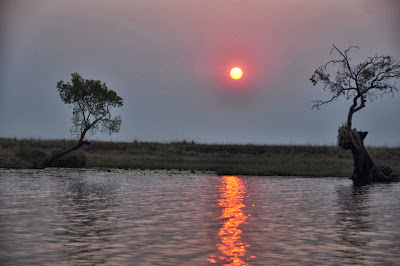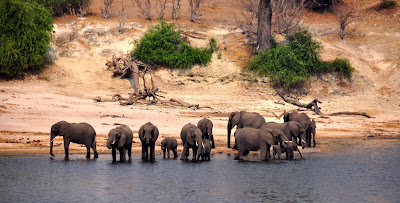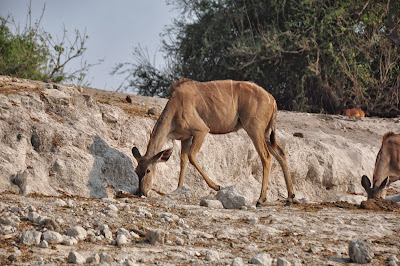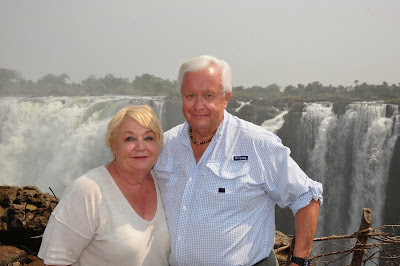 |
| Greetings from Victoria Falls! |
There is a debate about when is the best time to visit the Falls. Some will tell you the end of the rainy season, in April, because the full force of the falls are on display. The spray from the Falls rises to a height of 1300 feet and can be seen from 30 miles away. It is the largest continuous curtain of water in the world at over a mile in width and it falls around 350 feet. The problem is that if you hike the trail that we did, you can't get close to the edge, see the bottom, or most of the falls for that matter, and you get soaking wet. I can't imagine photographing that spectacle. The natives call the place "the smoke that thunders" because of the roar that accompanies the spray. It must be quite a loud, soggy, wet, spectacle.
On the other hand, if you go during the dry season, you actually get to see the Falls fall and the river at the bottom. If you are really adventurous you can even swim in some of the pools formed on the Zambian side or go rafting at the bottom. Some even hike through the shallows to picnic on the edge. We chose merely to hike, admire and photograph. In the 110 degree heat, that was enough.
The following are just some random shots of the falls. It is nature at it's best. It's a place to be in awe and just observe. Unlike Niagara Falls, the area is much like when David Livingstone first laid eyes upon it in 1865.
All in all it was quite a spectacular sight, but it really needed to be to compare to the magnificent colonial hotel we were staying at for two nights. Built in1905, to accommodate passengers on the Cape to Cairo railway, and later the BOAC flying boat service from South Africa to Southampton, it has withstood and survived the significant political upheavals during it's time as Rhodesia and then under the dictator Robert Mugabe who has held power since 1980. This palace exists in a country with 80 to 90% unemployment and where the tour guides warn you not to discuss politics.
This is a view of the bridge that goes over the gorge. You can walk down the landscaped lawn to get a picture of it. It is also a place one can bungee jump from. It can't be seen from the terrace in rainy season.
On our first night there we skipped the native dancers show to have dinner in their gourmet Livingstone Dining Room. A seven course, prix-fixed meal, on tables set with starched white linen table clothes, more silver and glasses than one could imagine and a very inventive menu not to mention wine paring. There were candles on the tables and the waiters were all in tuxedos. It was wonderful. All for the glorious price of $35 per person and $30 per person for the wine pairing. We ate with our friends from Edmonton and had a blast. It was their lovely daughter's first experience with this type of dining and her comments were priceless. It couldn't have been a better evening.
You can't venture out of the enclave that is the town of Victoria Falls and not be touched by the tragedy that is Zimbabwe. The people are truly suffering. As I have shown in other posts, village life is tough, but here it would be near impossible without the aide NGO's bring into the country. Yes we were in a very special place nestled amongst subsistence living, but each tourist jobs can support up to fifty to sixty people. I hope we helped in some small way.
Africa was coming to a close. The last thing we did was go for a sunset cruise on the Zambezi River. It was a wonderful end to a most wonderful trip. Leisurely cruising on the river with fifteen new found friends, enjoying memories, appetizers and wine. The next morning we'd all be off to distant places. Some were going to Cape Town, others to Edmonton and Seattle. We were off to Amsterdam, another twenty four hours of travel. All in all, it was worth every bump in the rutted roads we experienced.
Now this trip was truly enhanced by the people we traveled with and I would be remiss in not thanking them again for helping make this trip so memorable.
 |
| The group from Calgary. A more welcoming group could not be found. |
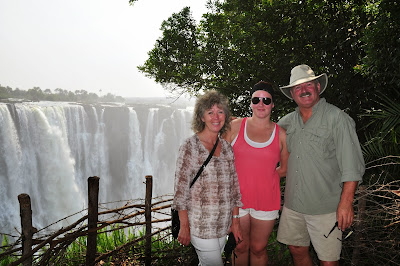 |
| Anita, Nikki and Bob from Edmonton. We had a blast with them. From Nikki I learned that decals were dec'als in Canadian. |









































